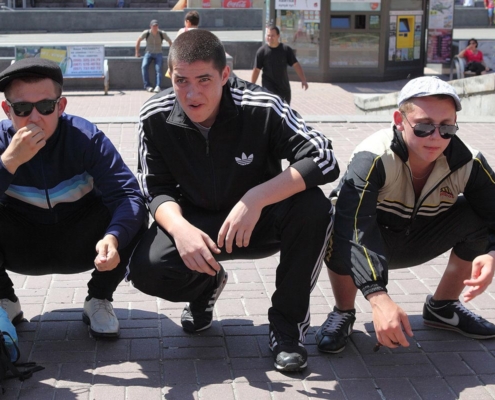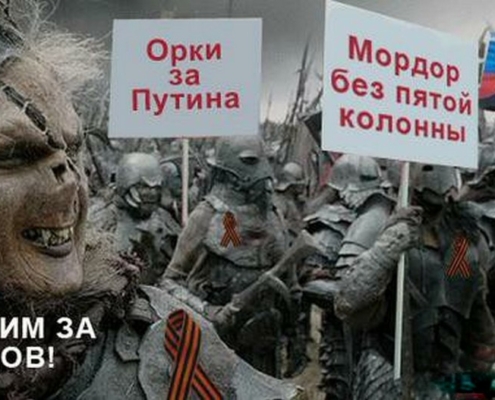Having in my previous article outlined the political and ethnic shenanigans leading up to the Ukraine conflict, this article examines in some granular detail the current progress of the war in light of what appears to be previously recognized limitations in the Russian logistics chain and the development of their war doctrine, including the use of nuclear weapons.
Observers of the Ukraine war have been surprised at the initial Russian movement towards Kiev, then its apparent retreat, until we see a current Russian force disposition amounting to a belt running interior to the southern, eastern, and northern border of Ukraine, not much more at its furthest than 100 miles in all positions from the Russian or Belarus borders.
In addition, it seems obvious that either due to a distaste for causing civilian casualties or a simple lack of capability, the Russians have been able to take few Ukrainian cities outside of the near Donbass and, most recently, Mariupol.
However, clues to what is going on and what may happen next may appear in a group of not-well-publicized articles written by U.S. military defense specialists.
In a little noticed article in War on the Rocks, Alex Vershinin, a recently retired Lt. Col. In the U.S. Army, “pointed out in 2021 that the Russians, in contrast to the Americans and NATO, have very limited logistics capabilities. He estimated that the logistical chain of a Russian invasion, say of the Baltics, would be limited for a significant period of time to a range of an incredibly short 45 miles from the Russian border. This, he says, is due to the fact Russia has an extreme shortage of road transport as compared to Western armies. In Russia, the main transport is by rail. Unfortunately for Russia, Russia uses the wide 1.520 mm gauge railway, while the rest of Western Europe, including the Baltics, uses the narrow 1.470 gauge railway. Accordingly, anything shipped by rail must undergo significant border delays while bogies are exchanged, not only creating delay but offering an ample targeting opportunity for enemy forces. In that “delay time,” Vershinin postulated, NATO could bring its rapid-deployment reinforcements into play, creating a much more difficult struggle for the Russians.
How does this impact the Ukrainian war? Although Ukraine uses the same gauge railway as Belarus and Russia, like most European countries, all the rail hubs are in the major cities. The principal rail hubs of intersecting rail lines appear to be Kiev and Kharkov, neither of which the Russians have yet been able to take, apparently afraid of being bogged down in another Stalingrad. However, without access to the cities through which the rail lines run, can the Russians actually supply their troops adequately with rail? According to a recent Bloomberg article by Mark Champion, “How Ukraine’s Rail Network Threw Russia’s Military Off Track,” not likely:
Ukraine — unlike Western Europe — uses the same gauge of railroad as Russia. That infrastructure, though, can’t be used to bring supplies until troops control the towns that sit on them, in particular key junctions such as Kharkiv, Sumy and Chernihiv in the north, or Kherson, Mykolaiv and Zaporizhzhia in the south. …
The problem for Russia is that its military needs to take major cities to access the rail network, Vershinin [cited above] said by telephone from Virginia. “The other problem is that the Russians have not brought enough manpower,” he said. “This is a huge country, and every time they need to take a city they also have to leave force behind to hold it.” That means the military also can’t yet run out temporary pipelines to deliver fuel, because they don’t control the territory and can’t rely on locals not to destroy them. Instead, oil tankers have to be sent by road, putting further stress on a limited resource.”
In Ukraine, Russian units have had to travel long distances from supply depots. That isn’t necessarily a failure, but it means there have to be pauses in an advance to allow supplies to catch up. That creates a special problem for Russia because its military carries three times as many artillery pieces and multiple launch rocket systems as the U.S. military does. Reloading just the rocket launchers of a Russian army — units of which there are several in Ukraine — takes as many as 90 trucks per volley, based on Vershinin’s math.
“Once Russian forces control the railroads, they’ll be able to move fuel, ammunition, and equipment to the front much more efficiently [emphasis added], according to Roger McDermott, a Russian military specialist at the Jamestown Foundation, a U.S. think tank. That suggests even darker times ahead for the Ukrainian armed forces and civilians on the receiving end. Despite the “mystifying lack of planning,” the Russian military historically has tended to make early errors and then learn quickly from them, according to McDermott, who also works at the Foreign Military Studies Office at Fort Leavenworth, Kansas.[2] “If you get hold of one of the old Soviet maps of the rail structure, you can start to make sense of why they are putting so much importance on a place like Kharkiv,” McDermott said. “Once they have the rail hubs and can control the rail roads, they can start to fix a lot of the problems they’ve had.”
If not, the only alternative is supply by trucks, which puts the Russians almost in the same place as they would be had they invaded the much smaller Baltics with their nasty, narrow-gauge track. Unfortunately, in addition, most of the big highways go through cities, even if the Russians had enough trucks. Going “off road” in the muddy springtime is unlikely.
A look at the present Russian-conquered territory would appear to provide indirect evidence for this logistical thesis. The Russian-acquired territory resembles a fringe, or ring, lining the border of the Ukraine — almost from Odessa on the West, along the Black Sea coast to the Russian border (Mariupol is the last Ukrainian city to fall on that border), and up from the Black Sea along the Western border of Russia through part — though not yet all — of the Donbass, with an additional northern strip extending somewhat north of Kiev. Crucially, as noted, except for Mariupol, no cities, and thus no railroad hubs, have yet been taken. This belt varies in width, but appears to approximate 50 to 100 miles at the maximum. This disposition of Russian success would appear to accord with the logistical issues noted in the above-cited article.
Of course, over time, as supplies are moved forward, the Russians can move deeper into Ukraine, railroad or no railroad, if they can neutralize the remaining Ukrainian armed forces.
On top of these problems, the Russian Army at the time of its entry into Ukraine and now is on a peacetime, rather than a wartime, footing. Not only is the army thus smaller in gross numbers that it would be if put at full-strength wartime footing, but the reduction in strength, as is common in many armies, is expressed in a way that makes offensive operations even more difficult than a mere uniform shortfall of troops would suggest. Specifically, in contrast to, say, 50 years ago, the bulk of troops are brought to the front in armored vehicles. It typically takes a crew of two to man these vehicles (apparently these buggies are more complex to drive than a Honda). The carriers can hold eight soldiers, which leaves 6 combat infantryman that dismount and commence fighting. Many armies, of which to its regret the Russian Army appears to be one, maintains its reduced peacetime force not by reducing the number of armored personnel carriers, but by keeping the personnel carriers constant and removing infantry. So if there are so few troops that there are only 3 or 4 men per APC, given that a minimum of two will have to be non-combat-infantry drivers, that leaves only two, instead of eight, infantrymen per-APC.
Thus, a 50 percent reduction in troop levels to achieve a peacetime force level can reduce actual combat infantry by an astounding 2/3rds— instead of 6 infantrymen per APC, you now have only two. Plus the ubiquitous two drivers, of course. If you toss in a repairman or two — these vehicles seem constantly to be breaking down — plus men to drive the oil tankers to refuel the vehicles, you have a significant reduction in combat capability. This supposition has been confirmed by the many captures or kills of such vehicles containing only 3 to 4 persons — essentially “ghost” APC’s as it were.
Did Putin, a former FSB (not Army) man realize this? Were his senior military leaders too afraid to inform him? Putin appears to be oblivious, showing more concern for his domestic poll ratings than for the military requirements of the invasion. In late April, Putin had the opportunity to extend the contracts of existing soldiers for a year, while adding a new cohort of 130,000 soldiers. Despite the reported rage of his generals at the decision, he refused. So the veterans will soon be returning home to be replaced by green conscripts. Shades of Vietnam’s one-year rotations?
Moreover, Putin seems to have rejected out of hand a declaration of full mobilization, which could raise north of a million potential soldiers in addition to those already conscripted. Fighting a significant war with less than significant means has never been a good idea, and may not work out well for the Russians either.
Nevertheless, the Russians appear to be grinding on, though at the edges, within their apparently limited logistical leash.
But if the Ukrainian army is resupplied (adding insult to injury, by railway, of course) from the West, its firepower and combat effectiveness will presumably increase substantially just as the Russians finally mover their supply sources up far enough to allow them to move farther in.
A foretaste of this is exemplified in a Wall Street Journal report by Thomas Grove, March 5, 2022, in which he reports that Ukraine is starting to strike the logistics hubs just inside the Russian border to disrupt Russian supply even through their already too-short logistical supply line. Ominously, these strikes may become much more effective if US supplies get through:
The Institute for the Study of War said in a report that Ukrainian forces will likely continue to conduct cross-border strikes to disrupt Russian logistics, possibly with drone or missile strikes. But new weapons that the Ukrainians will receive from the West are much more powerful than anything they or the Russians currently have, raising the possibility of more strikes deeper inside Russian territory. (Emphasis added.)
See also: Kateryna Stepanenko, Karolina Hird, and Mason Clark, “Russian Offensive Campaign Assessment, May 4, 2022,” May 4, 2022, Institute for the Study of War.
Thus, to defeat the Ukrainian armed forces, or perhaps, as the Wall Street Journal indicates, to avoid defeat itself, the Russians will need, among other things, to interdict the massive supplies of high-quality armament coming in from the West, primarily by rail, or risk a completely new and more dangerous kind of war against an enemy with a bunch of nasty weapons presumably not anticipated in the Russian war plans.
Romania, Slovakia, and Poland (the three countries other than Hungary that, apart from Belarus and Russia, border Ukraine) are permitting re-supply through their countries, which presents a significant logistical challenge for the Russians. How are the Russians likely to interdict these shipments?
Plan A would be for the Russians, from long distance, via conventionally armed missiles or air power, to bomb each of the rail lines near but inside the Ukraine border to keep all the rail lines permanently disabled. I have seen no analysis of how much materiel this would take and how likely it is to be accomplishable.
Plan B would be to take advantage of the fact that the West uses 1.435 mm narrow-gauge track, whereas Ukraine (like Belarus and Russia) uses 1.520 mm wide gauge track. This means that each train incoming from the West to Ukraine needs to stop for quite a while, while the whole train is crane lifted up and the underlying wheeled bogies are changed to the proper gauge. (See the video at “Ukraine wants to connect to Europe in 1.435mm” — Mediarail.be — Rail Europe News). Russia could thus wait until trains were halted, changing their bogies at or near the border. This would afford Russians the time for a leisurely and, presumably, more accurate and devastating strike on actual supply trains. This could in theory simply wipe out any and all incoming freight trains without the nuisance of the intensive bombing required to permanently disable track.
The countermove of course would be for Poland, Slovakia, and Romania to construct 1.520 gauge railways a few miles into their national borders and change bogies there. The temptation for the Russians would be to bomb inside those NATO countries, giving rise to a potential NATO Article 5 response, leading to a significant escalation. Oh-oh. The brilliant Poles already thought of this. As we sit today, a 1.520 gauge track goes from Lviv in Western Ukraine to the Eastern Polish rail terminal at the city of Przemyisi. (For pictures of the beautiful, restored [so far, until Russian bombing] rail station, see the previous link.) So, perhaps the sneaky Poles would change bogies in Przemysi, not at the Ukraine border. Whoa! Do the Russians bomb that straight off and trigger NATO Article 5? Or do the Ruskies wait until Putin gets angry and then trigger Article 5, not to mention destroying a lot of historic architecture to boot?
In evaluating the likelihood of such sustained pinpoint conventional attacks, one must note that the accuracy of modern missiles and other armament depends heavily on microchips. It is not clear if the Russians have their own foundries from which they can re-supply these super accurate missiles. If not, then the sanctions regime — interdicting microchip supply from Japan, Taiwan, the United States, and Western Europe (think ASML) might result in the Russians being completely out of weaponry once their existing inventory was depleted. This would impede their ability to conduct the precise strikes required for Plans A or B.
Note this excerpt from a recent RAND report setting forth RAND’s analysis of current Russian military thinking regarding escalation to nuclear weapons:
One report [citing certain Russian-language sources], for example, noted that the maintenance of a stockpile of tactical nuclear weapons is, in part, a means to respond to a large-scale (i.e., not localized to a single region) NATO conventional aerospace attack involving thousands of cruise and ballistic missiles, and that Russian tactical nuclear weapons could be used in the early phases of such a war. The lack of ability to respond in kind to a conventional aerospace attack with precision munitions has been described as NATO’s “escalation dominance,” because Russia, given the assumption of inferiority in precision munitions, platforms, and enabling infrastructure, could be faced with the choice between capitulating on unfavorable terms or escalating to nuclear use with the accompanying risks of mutual assured destruction that would bring. As a result, since 2011, Russia has been attempting to reduce the quantitative imbalance by rebuilding its own conventional long-range strike capability and capacity as a form of nonnuclear deterrence. Clint Reach, Vikram Kalambi, and Mark Cozad, Russian Assessments and Applications of the Correlations of Forces and Means, RAND (2020), at p. xiii, RAND_RR4235.pdf
This implies that Russia may not be able to effectuate Plans A or B, since it appears — according to its own analyses — not to have sufficient precision conventional capability.
Indirect evidence suggests this situation may be playing out now. There is no evidence more than two months into the war that the Ukrainian railway passage to the West has suffered serious interdiction. In fact, the ISW report cited above notes as of May 4:
Russian forces intensified airstrikes against transportation infrastructure in Western Ukraine on May 4 but remain unable to interdict Western aid shipments to Ukraine. Six Russian cruise missiles hit electrical substations near railway stations in Lviv and Transcarpathia (the southwestern Oblast of Ukraine) on May 4.[1] A senior US defense official reported that Russian aircraft conducted 200 to 300 airstrikes largely targeting transportation infrastructure in the last 24 hours.[2] The US official added that these Russian strikes are likely intended disrupt Ukrainian transportation capabilities and slow down weapon re-supply efforts but have been unable to do so. (Emphasis added.)
Thus, it might be concluded that, for one reason or another, the Russians are incapable of executing Plans A or B. Now it is worth mentioning that the reports from ISW may be less than fully accurate as regards Russian victory or defeat, given that it is a think tank founded and operated by the notorious Kagan family (of which Victoria Nuland is an in-law). However, it certainly gives a bird’s eye view into how the Neocons see the future of this war proceeding — direct attacks on Russia never contemplated during 8 years of US aid to Afghanistan. This all could be very bad news. For everybody, including the West. Even for those at ISW’s and RAND’s Washington DC office.
Plan C. If Plans A and B fail or are impracticable, another tactic the Russians would be tempted to use, which would be consistent with publicly announced Soviet military doctrine pre-1982 (see V.D. Sokolovskii, Soviet Military Strategy; translated by RAND Corporation for the U.S. Air Force, 1963, at 411), would be the much easier task of dropping tactical nuclear weapons on railways near to border, as well as highways.[1] This would accomplish two objectives: First, due to the greater power of the nukes, a handful of not very accurate bombing runs or missile hits would take out the entire surrounding railroad. Second, the bombing would create a radioactive radius around all border rail facilities which would impede border crossings by rail (or road). This tactic was discussed in Soviet Military Strategy, at 414, where it was noted that a likely strategy in a war involving tactical nuclear weapons would be the laying down of an entire radioactive belt, which would prevent troop passage until the radioactivity died down. This (plus a no-fly zone) would effectively cut off supply to the Ukraine from the west.
If, in response, NATO ground troops massed to attack Ukraine, Russia would then presumably lay down a nuclear “field of fire” to create a radioactive band stretching from the Baltic to the Belarus border consistent with old Soviet nuclear war doctrine (Ibid.). This might prompt NATO to invade through pleasantly radiation-free Belarus, thus bringing Belarus (and undoubtedly Russia) directly into the war. At that point, even Putin’s restrained 2020 doctrine of nuclear weapon use would permit any and all use of nuclear weapons, as a defense of the homeland. The result probably would be strategic-level nuclear strikes on any concentrated NATO ground formations, plus supply depots.
Since much of the supply to the NATO troops would presumably also go by rail, the best way to disrupt NATO troop movements and re-supply would be the nuclear destruction of European cities such as Warsaw and Berlin, since such cities are the principal railroad hubs, the destruction of which would cripple movement of supply by rail.
Needless to say, the nuclear bombing of Warsaw, Berlin, Munich, Prague, etc. with 500 kiloton warheads, wiping out, in addition to the railways, a good part of the civilian population of those historic cities, including, let it be said, a lot of newspaper editors and “talking heads,” would further escalate the war, perhaps uncontrollably.
In addition, to the extent any supplies were coming directly from the US to mainland Europe, the use of missiles and submarines to interdict and sink sea freighters and air-to-air missiles to destroy air transport in flight would further escalate matters. The consternation inside Western capitals might trigger unpredictable responses.
Thus, the very weakness of Russian conventional forces — either in accuracy or in inventory of weapons, if that proves to be the case — could lead it to the use of tactical nukes, with unpredictable consequences. And even if current Russian armament is enough to effectuate Plans A or B, what if, once the inventory is run down, Russia is unable to replenish the inventory due to, as noted above, sanctions on various hi-tech components such as microchips.
What a contrast to Joseph Stalin! What comparative humiliation! Stalin methodically prepared for a massive war in which he assumed the Soviet army supplies would have to be replenished solely from Soviet sources. He spent 8 years building up — with assistance from such Western companies as Ford (which was of course also helping Hitler!) — a massive vertically-integrated production system, from mines and oil, to factories for all components, all replacement parts, to finishing factories for all types of armament; in addition, during the war, substantial R&D continued, further enhancing Russian-made weaponry.
It is said that Russia still has significant inventories of relevant weapons, and that the Ukrainian war has reduced Russian stockpiles by only 20%. But after 10 more months, 20% goes to 100%. In contrast to Stalin, therefore, it appears that Putin’s infrastructure preparation may have been amateur hour. A display case of fine looking weaponry good for 8 or 9 months, with nothing in the back room for spares. He may have been misled into believing the war would be so short that existing supplies were more than ample. If so, he made the same disastrous mistake, ironically, of which Hitler, in the reverse position, has been accused.
The tragedy will be if, instead of inducing negotiation or retreat, this situation impels Putin to up the ante to the nuclear level.
A wise statesman such as Kennedy or Nixon would give Putin a path of face-saving retreat, through some negotiated settlement that met some, if not all, of Putin’s relatively modest pre-war demands. However, our leaders are neither wise nor statesmen. Not only are they effectively refusing to negotiate — still demanding the Crimea! — they now accuse Putin of war crimes and assert that they will prosecute him if they win. Astounding. They appear to be leaving Putin the choice between (1) national and personal humiliation and possible harassment and jail time (remember Saddam Hussein anyone?) and (2) nuclear war. We may have met our man. He may well just choose Monty Hall’s door number (2) and “let ‘er rip.” Personally, at least, what does he have to lose?
Hey, wanna buy a condo in New York City?
Or, on reflection, would a shack in Tierra del Fuego with a real deep basement and about 4,000 cans of Spam and bottled water be more to your taste?
NOTES:
1/ Sokolovski states “In a future World War the basic weapons in ground theatres will be nuclear weapons, used primarily with operational and tactical missiles and front line air forces (bombers, fighter bombers, and fighters). In addition, Strategic Missile Forces and the Long Range Air Force will deal nuclear blows to targets in the zone of the advancing fronts.” pp. 410-411.
2/ Roger N. McDermott specializes in Russian and Central Asian defense and security issues and is a Senior Fellow in Eurasian Military Studies, The Jamestown Foundation, Washington DC, Senior International Research Fellow for the Foreign Military Studies Office (FMSO), Fort Leavenworth, Kansas, and Affiliated Senior Analyst, Danish Institute for International Studies, Copenhagen. McDermott is on the editorial board of Central Asia and the Caucasus and the scientific board of the Journal of Power Institutions in Post-Soviet Societies. He recently wrote The Reform of Russia’s Conventional Armed Forces: Problems, Challenges and Policy Implications (October 2011).
























